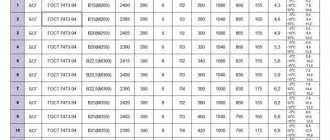How many potatoes are in a bucket
In this article we will tell you how many potatoes are in a bucket. It has long been clear that supermarkets sell not very tasty potatoes. Let's say the potatoes may be old and not stored properly in the warehouse. This will affect the taste and beneficial qualities of potatoes. Therefore, you have to buy potatoes on the market from a private owner. Almost everyone who cooks their own potatoes does this. Because these potatoes are very tasty and fresh. When such potatoes are cooked, a very aromatic smell appears, which makes you really want to taste this ordinary and simple food product. The taste of potatoes greatly depends on the quality and variety of potatoes. When coming to the market, private traders (sellers) who are constantly selling potatoes measure the weight of the potatoes in buckets. Because it's simple and fast. Some potato sellers don't even have scales. And buyers often raise the question of how many kilograms of potatoes are in a bucket. Did the seller deceive the buyer? To do this, we have compiled a table for you.
How many kilograms of cement per cubic meter
In general, answering this question is not as simple as it seems. Firstly, cement can be of different brands. Depending on the brand, it changes its density, and therefore its weight. Portland cement weighs more than low-grade cement and the difference is significant.
Secondly, Portland cement is obtained by grinding special clinker. As a result of grinding, a dusty substance is obtained, which is called Portland cement. The true density of cement is 3100 kg/m³. But each particle retains a certain amount of air and therefore the volumetric mass of cement is less. But this is also not a constant quantity. Immediately after production, cement retains the maximum amount of air and therefore weighs less. The mass of a cube of cement grade M400 and M500 immediately after production is about 1100 kg/m³.
How much does a cube of cement weigh: specific gravity of different types
During storage and transportation, it is compacted and moistened. So one cubic meter of cement can already contain 1600 kg. For calculations, take the average value - 1300 kg/m³. So if you need to know how much a cube of cement weighs, we take the average values. For M400 and M500 calculations take 1.3 tons per cubic meter. If you need to convert cubic meters of Portland cement to tons or kilograms, use these numbers.
How many potatoes are there in a bucket of 5, 10, 12 liters?
Important : in the table measurements, the potatoes were placed with a small mound!
A five-liter bucket holds 3 kilograms of large potatoes and 3.5 kilograms of small potatoes.
A ten-liter bucket holds 6.5 kilograms of large potatoes and 7.5 kilograms of small potatoes.
A 12-liter galvanized bucket holds 9 kilograms of large potatoes and 10 kilograms of small potatoes.
Most often, private owners use five or ten liter buckets. Because most often, lovers of fresh and tasty potatoes buy no more than 5 or 10 kilograms of potatoes. Since the buyer has no place to store such a large volume of potatoes at home. Let's say you need to measure 5 kilograms of large potatoes in a 10 liter bucket. The seller almost fills the bucket with potatoes and it will be exactly 5 kg.
We can advise you to look at our measurement table. Very useful information that will be useful to any housewife in the kitchen.
If our article helped you, then thank us. Please share the article on social networks. In this way, you will thank the author for the information provided to you.
How many kg of cement are in the bucket, how much sand and how much gravel
Who's on the site
There are currently 22 guests online
| You can prepare good concrete only by correctly calculating the required amount of its ingredients and measuring them accurately. The most common “measure” for construction bulk materials in country construction is an ordinary ten-liter bucket, but in order to use it “wisely”, you need to know how many kg of cement are in the bucket, how much sand and gravel can be placed in it. So, an ordinary 10-liter garden bucket contains: cement - 13-15 kilograms, depending on its compaction during filling; construction sand - 14-17 kilograms, depending on its humidity; gravel or crushed stone - 15-17 kilograms, depending on depending on the fraction; medium moisture clay - 12-13 kilograms; lime paste - 12 kilograms. Of course, it is impossible to determine absolutely exactly how many kg of cement or sand are in a bucket or sand without knowing their density, but when making cement, you can take the average values from the above. |
www.vseznayem.ru
How much does a bucket of cucumbers weigh (without a slide and with a slide)?
There are some nuances in this issue that need to be taken into account, for example, the shape and size of the fruit. The average density of a cucumber was also calculated, so everything must be taken into account and based on the average value. We take those same averages and get the following results:
– a bucket with a volume of ten liters equals – 7-7.5 kilograms (if without a slide)
– with a slide, the same volume weighs approximately 7.5-8.5 kg.
Therefore, if you take a five-liter bucket, then we divide the indicators in half.
How much does a bucket of potatoes weigh?
The most popular crop is, of course, potatoes, which are also called second bread. Very often, when stocking up on crops for the winter, when purchasing, we are faced with the following question: “How many kilograms are in this bucket?”
So here, first of all, everything will depend on the volume of the bucket, the size of the fruit, and so on. If we take a 10-liter container and fill it to the top with vegetables, then we will get 6.5-7.5 kilograms, if we take a 12-liter container - about 10 kilograms.
Here you need to know that there will be more small potatoes in the same bucket than large ones, since if the potatoes are large, there will be more empty space in the container.
How much does a bucket weigh
When going once again to buy products for jam, compotes, pickles, or simply stocking up, most of the population takes a bucket with them.
Therefore, it would be useful to find out how many kilograms of food fit in a bucket. Potatoes have long become a popular “independent” product in our menu, as well as an indispensable component of many dishes. Therefore, this gardening food product is purchased not in kilograms, but in buckets or even bags. How much does a bucket of potatoes weigh? This question is often asked by buyers at the market, stocking up on potatoes for future use for several months at once. Today we will learn about the weight of one “standard” bucket of potatoes, as well as other products and materials.
How much does a bucket of potatoes weigh?
A 10-liter bucket weighs 6.5 - 7.5 kg, and a 12-liter bucket weighs up to 10.3 kg.
The weight of a bucket of potatoes, first of all, depends on the volume of the container itself. For example, 6.5 - 7.5 kg of potatoes can be poured into a 10 liter bucket. The value of this indicator is also affected by the fullness of the bucket - if the seller generously poured a heaping amount of potato tubers, then the total weight will increase.
In addition, the material from which the bucket is made is taken into account. So, in an enamel bucket, the weight of the empty container is added to the weight of the potatoes - about 2 kg. And the weight of potatoes poured into a galvanized bucket with a capacity of 10 liters will increase by about 1 kg.
About 10.3 kg of medium-sized tubers can be poured into a 12-liter bucket, excluding the weight of the container.
How much does a bucket of potatoes weigh? Another deciding factor is the size of the tubers in the bucket. More small potatoes will fit into a bucket than large ones, and the filling of the space will be more dense. But large, elongated potatoes leave a lot of free space in the bucket.
For comparison: if you pour small and large potatoes into two identical containers and compare the weight, then in the first case the bucket will be a little heavier.
How much does a bucket of mushrooms weigh?
A bucket of mushrooms weighs from 2.5 to 10 kg. depending on the type of mushroom.
Mushrooms can differ not only in taste and general appearance, but also in density. Different types of mushrooms have different densities, which determines their weight. For example, let’s take a ten-liter container as a unit of measure. A bucket of chanterelles weighs 2.5 kg, honey mushrooms - 3 - 4 kg, saffron milk caps - 4 kg, porcini mushrooms - 4 - 6 kg, butter mushrooms - 10 kg. So, of these species, chanterelles are the lightest, and boletus mushrooms are the heaviest mushrooms by weight.
Volume calculation
Freshly made cement is always characterized by a lower density than that which has been on store shelves for a long time. Therefore, the indicators considered are also different. According to the construction standards that were signed and are still in force since the times of the USSR, the volume of cement containers weighing fifty kg was determined to be 0.0038 m3.
If it is necessary to calculate the number of buckets that will be required to lay the foundation or plaster of a large area, then, based on the formula described above, the volume in liters is taken as a basis, depending on the capacity of the container.
From fifty kg of dry cement mixture for work you will get:
- for a container with a capacity of ten liters it will be 2.4 kg, that is, about 2.5 buckets;
- for a container with a capacity of twelve liters it will be 3.8 kg, that is, approximately 4 buckets;
- for a container with a capacity of twelve liters it will be 3.2 kg, that is, approximately 3 buckets.
For production, different proportions are calculated. The basis should be the scope of application of the composition, what will happen as a result. To carry out foundation work, the density of the material used must be at least 2000 kg/m3.
The percentage ratio of cement, Al2O3 and Fe2O3 and gravel is 1:2:3. If you substitute the indicators into the formula, you will end up with three hundred kilograms. Knowing the specific density of concrete, which is equal to 2400 kg/m3, you get: 300 divided by 2400 = 0.125 m3.
How much does a bucket of cement weigh?
Question : Good afternoon! During construction, I always pour cement from a bag into a bucket; it is most convenient to carry it to prepare the solution. How much does a bucket of cement weigh? Can you tell me for 10 liter and 12 liter buckets? Thank you!
Answer : Hello! A standard bucket with a volume of 10 or 12 liters is the most convenient measuring tool when it comes to independently mixing concrete or cement mortar for masonry or plastering surfaces. In such cases, the working mixture is prepared based on the recommended ratios of volume units of components.
To calculate the mass of a material, we need to know its density. In the case of cement, you should not use specific density, but bulk density, since there are layers of air between the cement particles. The bulk density is indicated by the manufacturer on the cement packaging or in the passport/certificate for the bulk material.
The bulk density of cement changes over time, as it cakes and settles during loading and unloading, and during road transport on bad roads.
Bulk density of binder:
- in a loose state (immediately after manufacturing and packaging) – 1100-1200 kg/m 3 ;
- in a compacted, compacted state - up to 1600 kg/m3;
- average – 1300 kg/m3.
How many liters are in a bag of cement?
Enterprises specializing in the production of cement pack it in multilayer paper bags weighing 50 kilograms. However, due to the significant rise in price of this material, in retail trade you can find packages of 25, 30, 40 and 45 kilograms of cement.
Since, in everyday life or on small construction sites, for mixing concrete solutions, the components are measured in “liters”, “buckets” and “bags”, an inexperienced home craftsman has a legitimate question: “How many liters or buckets are in a bag of cement?”
In this article we will try to competently answer this fairly common question.
Method for calculating the number of liters of cement in a bag weighing 50 kg
As surprising as it may sound, cement is a very loose substance. Being in a powder state, it consists of microscopic particles of matter and air. Moreover, its density, depending on the “freshness”, ranges from 1,100 kg/m3 to 1,600 kg/m3.
Therefore, to simplify calculations, we assume that a volume of 1 m3 (1000 liters) contains 1,300 kg of substance. Accordingly, 1300/1000 = 1.3 kg of cement in 1 liter. Next, 50/1.3 = 38.46 liters of cement in 1 bag weighing 50 kg.
Round to the nearest whole number - we get 38.5 liters. Similarly, we calculate the number of liters of cement in 25, 30,40 and 45 kg bags, as well as the number of 10, 12, and 15 liter buckets in 25,30,40,45 and 50 kg bags. We summarize the obtained data in a table.
| Bag of cement, kg | Amount of cement, l | Number of buckets with a capacity of 10 l | Number of buckets with a capacity of 12 l | Number of buckets with a capacity of 15 l |
| 25 | 19 | 1+9 liters | 1+7 liters | 1+4 liters |
| 30 | 23 | 2+3 liters | 1+11 liters | 1+8 liters |
| 40 | 30,8 | 3+0.8 liters | 2+6.8 liters | 2+0.8 liters |
| 45 | 34,6 | 3+4.6 liters | 2+10.6 liters | 2+4.6 liters |
| 50 | 38,5 | 3+8.5 liters | 3+2.5 liters | 2+8.5 liters |
To summarize, it should be noted that the above data are averages. That is, in each specific case they can differ both up and down.
To accurately calculate the number of liters of cement in a bag, it is necessary to use state-certified laboratory measuring vessels and laboratory scales. At the same time, for private construction the given data are quite acceptable and have been tested in practice more than once.
orioncem.ru










